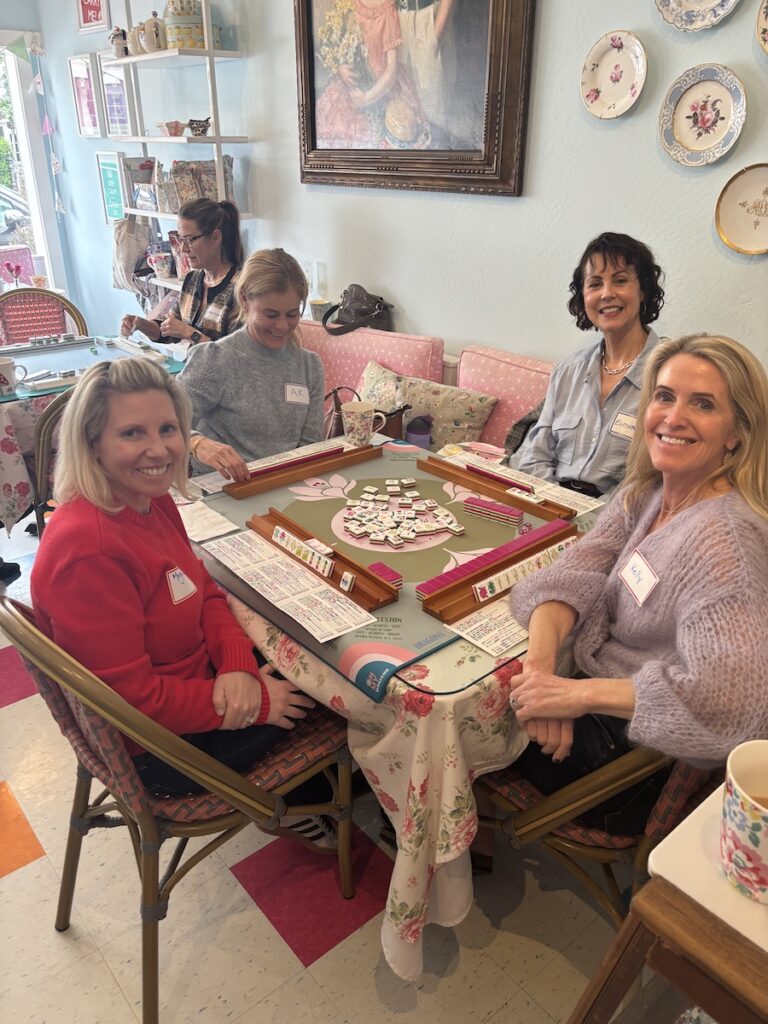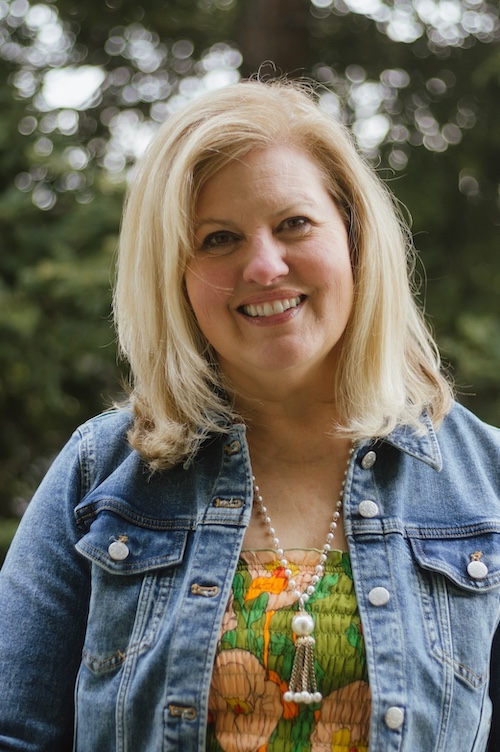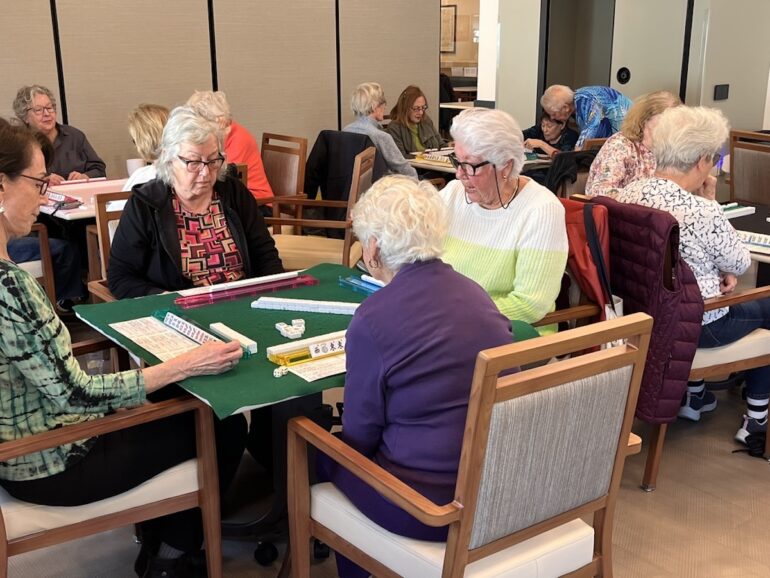It’s a late Monday morning in March, and the clackety-clack sound of tiles hitting tables reverberates through the room at Crown & Crumpet tea house in Ross. Seated around a table, Meghan Callinan studies her hand with focused intensity. She draws a tile and triumphantly declares, “mahjong!” as she lays down her final set of three of a kind to win the round.
Callinan, 45, is part of a rapidly expanding group of Gen Xers and millennials embracing the game of mahjong to connect with others, especially in a post-COVID world where former friendships have faded and people long for like-minded connections with others.
Many of those taking up the game are mothers of preschool or school-age children who forge friendships with others navigating the same stages of life. Take Kim Nash, for example: She found both a new circle of friends and a surprising passion when her children were in preschool and she started playing mahjong with moms in San Francisco. “It became mom’s night out or just our chance to skip toddler bedtime, which was fantastic,” she says. Later, when she and her husband moved to Marin, Nash not only continued playing, but also found herself teaching the game to other parents at her kids’ school — one of whom was Callinan.
Other women, like Jennifer Adams of San Anselmo, see the game as a mental respite from the stresses of life. The 51-year-old mom of two middle schoolers and the primary caretaker of an aging mom (who recently passed away) is part of the “sandwich generation.”
Adams was first exposed to mahjong as a child. “My parents played quite frequently, and my mom hosted monthly games at our house with her core group,” she says. “I called them ‘The Joy Luck Club.’”
Now, she regularly plays with a group of women through the Sleepy Hollow Homeowners Association, which regularly organizes games for its members.

Cracking the Code
For those unfamiliar with Mahjong — also commonly spelled Mahjongg or Mah-Jongg — it is a tile-based game played by four people and is reminiscent of Gin Rummy, as players must create various matching or numerical sets to win. Many consider it more of a game of luck than of skill or strategy, although it does require thought, memory and attention to detail.
The game of mahjong was first developed in Southern China in the mid-1800s. There are up to 40 variations worldwide, with two versions of the game acknowledged as the most popular: American Mahjongg and Asian Mahjong. Both versions are played with similar sets of tiles, with some variations. American Mahjongg has the addition of a yearly “playing card” giving players extra points for certain hands, keeping the game fresh and exciting. Gambling is often part of the game, but it can be played with or without money involved.
A Cultural Phenomenon
Mahjong first arrived in America in the 1920s and quickly captured the imagination of the social elite. Its popularity soared, especially among affluent women and men who based it on gambling. However, the game’s growing negative reputation as an ‘addictive gambler’s game’ along with its association with aging players and the shifting social dynamics led to its decline in mainstream appeal starting in the 1930s, even though it maintained its popularity among certain subgroups.
Many years later, the 2018 movie Crazy Rich Asians, featuring a powerful, symbol-laden mahjong scene, reignited public interest in the game. Soon after, celebrities like Sarah Jessica Parker and Julia Roberts publicly professed their love for mahjong, further fueling the revival.
Today, the centuries-old game is experiencing a renaissance. Specialty mahjong nightclubs, themed vacations and cruises, and an entire ecosystem of curated merchandise now cater to a new generation of enthusiasts. Mahjong designer tile sets starting at $400 are sold online as well as at luxury retailers such as Neiman Marcus and Anthropologie.
Bay Area businesses are riding the wave of mahjong mania too, turning the trend into clever marketing. In addition to Crown & Crumpet’s charming “Tea and Tiles” events which welcome up to 20 players for an afternoon of mahjong paired with traditional tea service, all three Mamahuhu restaurant locations — including the Mill Valley outpost — host “Mahjong Mondays,” featuring complimentary use of game sets, $5 beers and egg roll specials. The Marin Country Mart hosts free Sunday games in its big tent, which are often filled to capacity in advance.
Mahjong has made its way into community-based venues across the county, with public drop-in games offered nearly every weekday at community centers in Mill Valley, San Anselmo and San Rafael, as well as senior centers in Novato and San Rafael — all for a small fee or no charge at all.

Game On, Brain On
Leslie Friedman, who teaches American Mahjongg in both Marin and San Francisco, leads the weekly open play games at Vivalon in San Rafael. The games draw more than 40 players each week, primarily retirees, many of whom travel from across the county. But Friedman has noticed a shift: nearly half of her private clients are now in their 30s and 40s, including both working and stay-at-home moms. “There’s definitely a craze and elevated interest in mahjong,” she says. “I’m not quite sure where it’s coming from — but it’s there.”
One of Friedman’s regular players at Vivalon, Irene Cooper, a youthful 65-year-old, picked up the game a few years ago after watching her mother struggle with dementia for over a decade. “There are so many things you can do for brain health,” Cooper says. “Playing games is one of them.” Though she admits feeling nervous at first, she pushed through by taking several of Friedman’s classes. “It was anxiety-provoking in the beginning,” she says, “but I stuck with it.”
Cooper’s instincts are right. A review of 53 observational studies from Western and Asian databases, published by the National Library of Medicine, found that frequent mahjong play is associated with stronger cognitive function, better memory and improved mood. As a mental workout, it proves to be both engaging and effective, and has shown some promise to relieve depressive symptoms.
Turning Passion into Profession
Kim Nash, a former real estate project manager for nonprofits, felt a shift when she casually began teaching others how to play mahjong in Marin — and quickly discovered a natural talent for it. Inspired, she stepped away from real estate to immerse herself in the world of mahjong, eventually launching her own brand, Mahj On My Mind. In just two years, she’s taught nearly 300 people, from new moms in their 30s to a group of women in their 70s who once attended UC Berkeley and were looking for something new to do besides cooking together. Most of her students are women — only about four have been men — though she says she enjoys teaching anyone eager to learn.
Nash has also cultivated partnerships with local businesses, teaching at Loveski Deli in Larkspur and regularly hosting workshops at Book Passage in Corte Madera. At the suggestion of some of her students, she was the one who approached the owner of Crown & Crumpet with the idea of monthly mahjong tea parties. “It lets people pop in and sign up as their schedule allows,” she says. “Plus they get a little extra support and coaching in a fun, informal setting.”
“I love all of it, the history, the playing, the tile sets,” she adds. “(Mahjong) is good for the heart, it’s good for the brain. It’s such a great community builder.”

A freelance writer in Marin who writes about family, kids and parenting, Glass is the mother to one son, one dog and a hamster named Miss Geri. When she’s not writing, trekking up steep hills in Marin or driving her kid to sports practice, she and her family spend time in their tiny cabin in Lake Tahoe. She avidly supports the California Academy of Sciences, a world class science museum and research institution, and the Institute on Aging which provides much needed services to Bay Area seniors and disabled adults. Glass is obsessed with baking the perfect loaf of banana bread, something she makes so often she no longer needs to look at a recipe card.


